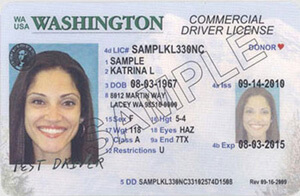

All your missed questions are saved
automatically for extra practice.




It's a practice test that's automatically made up of all your missed questions. Once you finish this test, you’ll be able to revisit your Challenge Bank™ to practice and sharpen your skills.
View All PlansAdding difficult questions to Challenge Bank™ is an exclusive Premium feature. Unlock access to 650+ exam-like questions, a Pass Guarantee, personalized study plans, and more.
View All Plans

The Exam Simulator mimics the actual exam. It will stop once you reach the maximum number of allowed mistakes.
WA CDL Hazardous Materials (HazMat) Endorsement Practice Test 2025
- Perfect for first-time and renewal CDL/CLP applicants, and those adding endorsements
- Based on 2025 WA commercial driver's license manual
- Triple-checked for accuracy
- Updated for July 2025
If you’re in Washington, this CDL HazMat practice test is for you!
All sorts of containerized goods arrive in the Port of Seattle every day. Massive cargo ships bring in automobiles, bulk commodities, electronics, and even dangerous products from the Asian continent. Washington serves as a gateway that receives and distributes these goods to the rest of the country, making a significant contribution to the U.S. supply chain. Once the ships are unloaded, trucks transport this cargo on the roads.
Hazardous materials are a special category of products that pose a risk to health, safety, property, or the environment. They include flammable gases, pesticides, explosives, infectious substances, and even radioactive materials. Given their high-risk classification, such cargo must be handled exclusively by trained professionals.
To transport these hazardous substances, you’ll need a Hazardous Materials (H) endorsement on your Commercial Driver’s License (CDL). This endorsement is granted after passing a written knowledge test, which covers topics like emergency procedures in case of a spill, hazmat classification, and federal regulations governing hazmat transportation. Additionally, you must also pass a Transportation Security Administration (TSA) Threat Assessment (background check). This is a complex subject that shouldn’t be taken lightly, as you wouldn’t want an unqualified driver to be responsible for such a dangerous task.
A good starting point for all students is the official 2025 CDL manual (https://driving-tests.org/washington/wa-cdl-handbook/), which contains information related to commercial driving, including the transportation of hazardous materials. However, those who truly want to master this subject will make good use of various online resources that significantly boost their learning journey.
Our CDL HazMat practice tests, specific to the state of Washington, closely mirror the actual written exam. Each test contains 30 questions with multiple answer choices, but only one is correct. Take as long as you need before selecting an answer, as there is no countdown to pressure you. Your score is permanently displayed and it updates in real-time, so you won’t have to wait until the end to know whether you’ve passed or failed. Detailed feedback is provided after each question, allowing students to develop a better understanding of the subject. This way, you can correct mistakes and increase your knowledge as you continue practicing.
About this test

What to expect on the actual WA DOL exam
questions
correct answers to pass
passing score
Are you in another state?
- Alabama: Test 1 / Test 2
- Alaska: Test 1 / Test 2
- Arizona: Test 1 / Test 2
- Arkansas: Test 1 / Test 2
- California: Test 1 / Test 2
- Colorado: Test 1 / Test 2
- Connecticut: Test 1 / Test 2
- Delaware: Test 1 / Test 2
- District of Columbia: Test 1 / Test 2
- Florida: Test 1 / Test 2
- Georgia: Test 1 / Test 2
- Hawaii: Test 1 / Test 2
- Idaho: Test 1 / Test 2
- Illinois: Test 1 / Test 2
- Indiana: Test 1 / Test 2
- Iowa: Test 1 / Test 2
- Kansas: Test 1 / Test 2
- Kentucky: Test 1 / Test 2
- Louisiana: Test 1 / Test 2
- Maine: Test 1 / Test 2
- Maryland: Test 1 / Test 2
- Massachusetts: Test 1 / Test 2
- Michigan: Test 1 / Test 2
- Minnesota: Test 1 / Test 2
- Mississippi: Test 1 / Test 2
- Missouri: Test 1 / Test 2
- Montana: Test 1 / Test 2
- Nebraska: Test 1 / Test 2
- Nevada: Test 1 / Test 2
- New Hampshire: Test 1 / Test 2
- New Jersey: Test 1 / Test 2
- New Mexico: Test 1 / Test 2
- New York: Test 1 / Test 2
- North Carolina: Test 1 / Test 2
- North Dakota: Test 1 / Test 2
- Ohio: Test 1 / Test 2
- Oklahoma: Test 1 / Test 2
- Oregon: Test 1 / Test 2
- Pennsylvania: Test 1 / Test 2
- Rhode Island: Test 1 / Test 2
- South Carolina: Test 1 / Test 2
- South Dakota: Test 1 / Test 2
- Tennessee: Test 1 / Test 2
- Texas: Test 1 / Test 2
- Utah: Test 1 / Test 2
- Vermont: Test 1 / Test 2
- Virginia: Test 1 / Test 2
- Washington: Test 1 / Test 2
- West Virginia: Test 1 / Test 2
- Wisconsin: Test 1 / Test 2
- Wyoming: Test 1 / Test 2
Your go-to, trusted source
Experience the Driving-Tests difference

The Exam Simulator mimics the actual exam. It will stop once you reach the maximum number of allowed mistakes.
